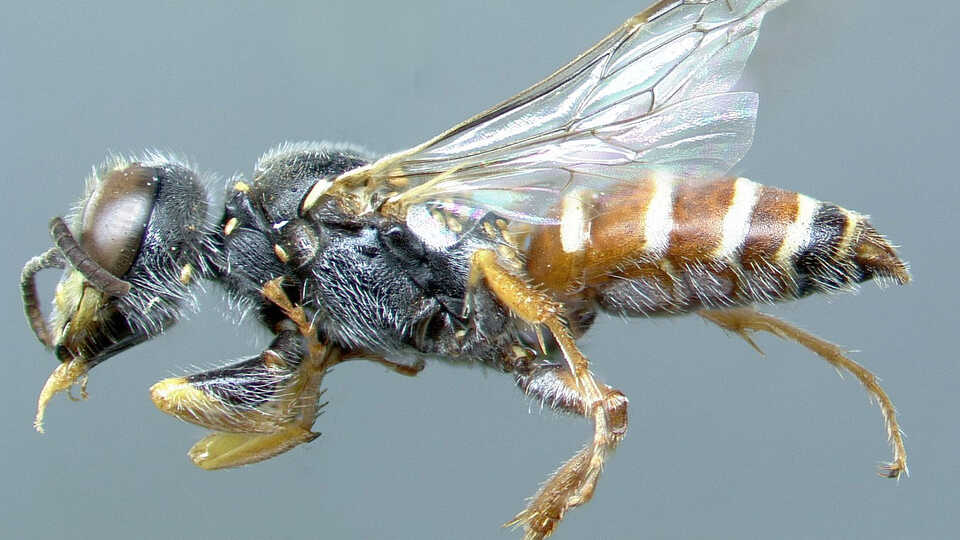
CATALOG OF SPHECIDAE sensu lato
(= Apoidea excluding Apidae)
compiled by
Wojciech J. Pulawski
Available on the internet since September 2003
Introduction
This catalog covers the families Heterogynaidae, Ampulicidae, Sphecidae, and Crabronidae. In the XIXth century, these wasps (except Heterogynaidae, added in 1969) were often combined with other primarily ground-nesting Hymenoptera into a single group, Fossores (or Rapacia), now known to be artificial. For example, Wesmael (1852) recognized seven families, each of them equivalent in rank to Mutillidae, Scoliidae, Sapygidae, and Pompilidae. In the XXth century, they were usually treated as a single family Sphecidae, following Taschenberg (1866), Fox (1894), Kohl's (1897) generic revision, and Bohart and Menke's (1976) authoritative treatment. Some authors, from Ashmead (1899) to Finnamore (1993), treated them as a superfamily and raised sphecid subfamilies to families. A frequently used argument was that sphecids were equal in rank to bees (Apoidea) and thus also must be a superfamily (Sphecoidea). A good overview of the differing opinions of treating Sphecidae as one family or several was provided by Menke and Fernández (1996) and Melo (1999).
The close relationship of bees and sphecids was recognized early by H. Müller (1872), and Handlirsch (1908) proposed Sphegiformia (properly Sphecoidea) to include both Sphecidae and Apidae, essentially treating them as sister groups. This classification has been strongly supported by Michener (1944), Brothers (1975), Bohart and Menke (1976), and Königsmann (1978), who all recognized one superfamily Sphecoidea (in contrast to other workers who accepted Sphecoidea and Apoidea). Michener (1986), however, showed that the name Apoidea has priority over Sphecoidea. Modern authors who treated sphecids and bees as sister taxa were Brothers and Carpenter (1993) and Finnamore (1993), among others.
Classification changed with the advent of cladistics. Lomholdt (1982), Alexander (1992), Prentice (1998, unpublished doctoral thesis), Brothers (1999), and Melo (1999) demonstrated that Sphecidae are paraphyletic with relation to bees (Prentice's classification was formally endorsed by Hanson and Menke, 2006). Alexander's results were somewhat inconclusive, but Prentice, Brothers, and Melo independently subdivided the extant Apoidea into five monophyletic families: Heterogynaidae, Ampulicidae, Sphecidae, Apidae, and Crabronidae. Their classification is accepted here.
About this Catalog
The catalog's main objective is to allow quick orientation in the vast body of the available literature on the four included families. The specific goals are:
1. to list all the valid names since Linnaeus (1758) and up to date, for both extant and fossil taxa (family-group, genus-group, and species-group names).
2. to list all the invalid and unavailable names (including junior synonyms, junior homonyms, and nomina nuda) for the same time period.
3. to provide information, for each nominotypical species, about the types status and sex, type locality, and depository.
4. to provide information about the actions affecting nomenclature (authorship of synonymies, lectotype or neotype designations).
5. to provide, for each species-group name, references to all subsequent publications with short information about the respective paper's content. This goal has been achieved only partially, but new data are being constantly added, both retrospectively and prospectively. The publications already cataloged are preceded by an asterisk (*) in the Bibliography. The missing data are expected to be gradually filled in the future. Many of the existing gaps are indicated by an ellipsis (...). A number of references not included here can be found in Dalla Torre's (1897) catalog.
Comments about the catalog, especially corrections of errors and omissions, would be greatly appreciated.
Full bibliographic references are given in the Bibliography section.
Acknowledgments
I sincerely thank the following individuals who helped correct errors or suggested improvement in the Catalog: John Alcock, Alexandr V. Antropov, John S. Ascher, Vassili Belov, Daniel James Bennett, Matthias Buck, Helen K. Court, Melody Doering, Hermann Dollfuss, Scott Federhen, Neveen S. Gadallah, Sven Hellquist, Chuck Holliday, John Huber, Hans-Joachim Jacobs, Stefanie Krause, Frank E. Kurczewski, Vincent F. Lee, Jean Leclercq, Tingjing Li, Stephen Morrison, Hirohiko Nagase, Pavel G. Nemkov, David Nicolson, Michael Ohl, Fabio Penati, Brunno Bueno Rosa, and Jere S. Schweikert.
_______________________________
Family-Group Names and Classification
Catalog of Madagascar Sphecidae
